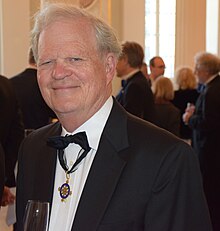James J. Sheehan
Jim Sheehan | |
|---|---|
 Sheehan in 2014 | |
| Born | 1937 |
| Nationality | American |
| Awards | Pour le Mérite |
James J. Sheehan is an American historian of modern Germany and the former president of the American Historical Association (2005).
Born in San Francisco in 1937, Sheehan earned a B.A. from Stanford University in 1958 and a Ph.D. (history) from the University of California, Berkeley in 1964. He taught at Northwestern University between 1964 and 1979, then moved back to Stanford to succeed Gordon A. Craig as Stanford's historian of modern Germany. At Stanford, Sheehan is Dickason Professor in the Humanities, Professor of History, and FSI senior fellow (courtesy).[1]
Sheehan's research focuses on German and modern European history, especially the history of German liberalism, the German Empire, and war and the modern European state. He is the author of numerous articles and several important books, including The Career of Lujo Brentano: A Study of Liberalism and Social Reform in Imperial Germany (Chicago and London: University of Chicago Press, 1966); German Liberalism in the Nineteenth Century (Chicago and London: University of Chicago Press, 1978); German History, 1770-1866 (Oxford: Oxford University Press, 1989); and, most recently, Where Have All the Soldiers Gone?: The Transformation of Modern Europe (Boston: Houghton Mifflin, 2008).[2]
He is married to Margaret L. Anderson, a historian at the University of California, Berkeley.
References
- ^ Home page at Stanford University
- ^ Wheatcroft, Geoffrey (10 February 2008). "Where Have All the Soldiers Gone? - James J. Sheehan - Book Review - New York Times". The New York Times. Retrieved 2009-12-20.
External links
- Faculty Page at the Stanford History Department
- James J. Sheehan, The Problems of Sovereignty in European History, AHA Presidential Address Retrieved 18 April 2010
